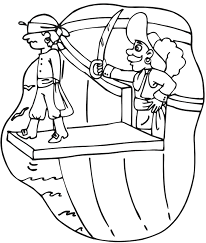A few days or weeks ago, I discussed the pirates of the Great Lakes in response to a question asked by one of our nieces. Some of you know that one of my favorite days is Talk Like A Pirate Day, and that I’ve alway been fascinated with pirates. Unfortunately a lot of the “colorful” things that pirates did and said, simply turn out to not be true, or at least not as romantic and adventuresome as we wish they were.
For instance, walking the plank… we’ve all seen movies where the blindfolded captive, prodded at cutlass-point is forced out onto a narrow board dangling over the sea — pirates must have done this, don’t you think? Actually, there is no proof that swashbucklers ever made their enemies and victims walk the plank.
One of the earliest definitions of the phrase “walking the plank” appears in the 1799 book A classical Dictionary of the Vulgar Tongue, which explains it as “a mode of destroying devoted persons or officers in a mutiny on ship board.”
Daniel Defoe who wrote Robinson Crusoe, was the first English writer to make his characters walk the “plank.” In his book A General History of Pyrates, he described ancient swashbucklers in the Mediterranean running a ship’s ladder out over the waves and telling their Roman captives they were free to go, so long as they were willing to swim for it.
In the 1800s, writers like Charles Ellms and Robert Louis Stevenson turned the ship’s ladder into “the plank.” Ellis’ book The Pirate’s Own Book included the drawing of a prisoner tumbling off the “death plank” into the sea. In 1887, Howard Pyle’s dramatic painting of “walking the plank” for a Harper’s Weekly article turned the plank into a visual icon that inspired all the pirate storytellers to come.

Most historians conclude that, while plank-walking did exist, it was relatively rare. If pirates did need to get rid of someone, it was much faster to simply push them overboard rather than set up a plank and have them do it themselves. In those rare instances when pirates had people walk the plank, it was probably simply because the pirates did it to amuse themselves on those occasions when there was time for it.
Another interesting theory as to why people were made to walk the plank was that the pirates couldn’t be tried for murder — after all the people walked off the plank themselves. This theory doesn’t hold much water though, because pillaging and piracy were generally hanging offenses anyway, so if they were caught, a murder charge on top of everything else wouldn’t make much of a difference.
But actually, I kind of like this theory — from what I can determine from my extensive research, no records exist of charges being brought against anyone who forced people to walk the plank, so maybe those old scalawags were on to something….
— 30 —
